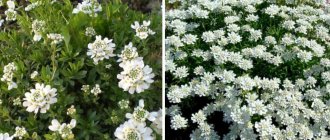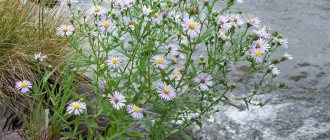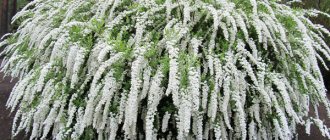Hydrangea (hydrangea) is a royal flower and a favorite of many gardeners. Its name is translated from Latin as “vessel of water.” And all because the plant loves water very much. Hydrangea does not require complicated care and delights with gorgeous blooms all summer long. The main thing in growing this plant is timely feeding and abundant watering. But in order for the inflorescences to be lush, hydrangeas need to be pruned in autumn and spring.
Blooming hydrangeas are beautiful in any area
Main types of garden hydrangeas with names and photos
This garden plant has several dozen different species, approximately 80 in total. But the most famous and widespread are only a few (photos and names of varieties are presented below). So, the most popular are:
- Tree-like − ornamental shrub with spectacular and lush inflorescences. Flowering period is from July to October. Easily tolerates harsh winter conditions. Grows well in both partial shade and sun. The plant forms new inflorescences on the current year's shoots. The most popular varieties of tree hydrangea: Annabelle, Pink Annabelle (you can see photos of these varieties of hydrangeas below).
- Paniculata is an incredible plant with gorgeous cone-like inflorescences. Inflorescences are divided into small (bisexual) and large (sterile). During flowering, paniculate hydrangea inflorescences can gradually change color from white to soft pink, and then to bright pink. A magical sight! New inflorescences form on the shoots of the current year. The most popular varieties of paniculate hydrangea are: “Pinky Winky”, “Bobo”, “Diamond Rouge” (photos of varieties are presented below). Varieties of beautiful hydrangea “Pinky Winky”, “Bobo”, “Diamond Rouge” will decorate any garden.
- Large-leaved (garden) - a gorgeous plant that can change the color of flowers. For example, a pink flower can turn blue or blue, and a red flower can turn purple. This occurs due to a decrease or increase in soil acidity. But large-leaved hydrangea with white inflorescences cannot be painted and does not change color. Inflorescences appear on last year's shoots. Therefore, if the shoots were cut off or frozen in winter, the hydrangea will not bloom. Large-leaved hydrangeas are pruned in the fall. The plant must be covered for the winter. This information is especially relevant for beginners. Because experienced gardeners know that large-leaved hydrangea is a very finicky plant. And it must be carefully looked after.
Paniculata hydrangea is the most winter-hardy plant species.
These types of hydrangeas are much less common:
- Oakleaf - this type of hydrangea is similar to paniculate inflorescences and has a delicate and subtle aroma. This is the main “highlight” of the plant. The leaves of oakleaf hydrangea are somewhat similar to oak leaves. They feel like velvet to the touch. There is one more feature. It lies in the fact that the leaves are bright green in summer, but with the onset of autumn they acquire a burgundy color, which looks very impressive in the garden. Unfortunately, this type of hydrangea is not common. But it must be said that it belongs to the frost-resistant species.
- Serrated - this hydrangea, like the large-leaved one, is capable of changing color due to the acidity of the soil. From soft blue to lilac. She needs shelter for the winter.
- Petiolate (garden vine) - this hydrangea can grow 20 meters in height.
- Sargenta - This plant blooms with beautiful pale purple flowers. The leaves are very large. For the winter, hydrangea must be covered.
Petiole hydrangea is able to absorb all nutrients not only through the root system, but also through aerial roots. But this plant is not particularly winter-hardy. The garden vine blooms with large white inflorescences. They emit a dizzying aroma that attracts insects.
Hydrangea has unusually beautiful flowering
There are varieties of large-leaved hydrangea that bloom twice: first on the shoots of the previous year, then on the shoots of the current year, for example, the varieties “Endless Summer”, “Liberteen”, “Fireworks Pink”. Therefore, such varieties are not afraid of spring pruning. You can see photos of the varieties below.
Favorite varieties of gardeners: “Endless Summer”, “Liberteen”, “Fireworks Pink”
Listen to the article
Hydrangea (lat. Hydrangea) are flowering plants of the Hydrangeaceae family, of which in nature, according to various sources, there are from 30 to 80 species. Among them are shrubs and small trees, growing mostly in East and South Asia, China, Japan, the Far East, and the Americas. The plant was named after Princess Hydrangea, whom no one remembers for a long time; later, when botanists were engaged in systematizing plants, hydrangea received the Greek name Hydrangea, which translates as “vessel with water” - the shape of the plant’s seed pods resembles a jug, and the plant itself is very loves water.
The Japanese call hydrangea "ajisai", which means "purple sun flower". It was from Japan that hydrangea was brought to Europe in 1820, and at first it was grown only as a houseplant due to its low winter hardiness, but breeders were so keen on cultivating hydrangea that by the middle of the 20th century more than 100 garden varieties were created. In our latitudes, garden hydrangea is represented quite widely - twelve popular species.
Why do hydrangeas need to be pruned?
If the hydrangea is not pruned, then it will take on a neglected and ugly appearance. The inflorescences will become small and flowering will decrease. But thanks to pruning, the inflorescences will be large and lush. Main tasks when pruning:
- Plant rejuvenation.
- Crown formation.
- Pruning for powerful growth of new shoots.
- Thinning.
- Removing frozen and weak branches.
After spring rejuvenating pruning of hydrangea paniculata there will be few flowers, but they will be very large.
Botanical description
Most of the hydrangea species are shrubs with a height of 1 m to 3 m; among hydrangeas there are both trees and vines that climb tree trunks to a height of up to 30 m. Among the representatives of the genus there are evergreen species, and there are deciduous ones, but in our latitudes they are grown namely the latter, blooming from spring to late autumn. Two types of flowers are collected in spherical inflorescences at the ends of the stems - sterile at the edges and fertile in the middle of the inflorescence. The flowers are most often white, but a species such as large-leaved hydrangea is represented by varieties with pink, blue, lilac and red flowers, and the acidity of the soil determines the color of the specimen. For example, hydrangeas with blue flowers grow in acidic soil, lilac and pink flowers in alkaline soil, and soft beige flowers in neutral soil. The fruit of hydrangea is a multipartite capsule with seeds.
- Tigridia: cultivation and care in the garden, types and varieties
In addition to large-leaved hydrangea, tree hydrangea grows well in our climate, known for its winter hardiness and ability to recover well from severe frosts. Paniculata hydrangea also overwinters well, known for its longevity - it can grow in one place for up to 60 years.
In addition to these three most popular species, such species as serrate hydrangea, serrate hydrangea, climbing hydrangea, radiant hydrangea, Sargent hydrangea, petiolate hydrangea, oakleaf hydrangea and others are known in floriculture.
When to prune hydrangeas in spring and autumn - dates by month
For many gardeners, especially beginners, questions such as: when is the best time to prune hydrangeas? In autumn or spring? How to prune correctly? And in what months should it be carried out?
So, the main pruning of plants is carried out in early spring, after the snow has melted, but before the sap begins to flow, around the end of March. Large-leaved hydrangea does not need to be pruned in the spring, since new inflorescences grow from the upper buds. You can only do a little cosmetic pruning. Below you can watch a video for beginners on how to prune hydrangeas in the spring.
Instructions for those who do not know how to prune hydrangeas
Tree and paniculate hydrangeas can be pruned in both autumn and spring.
In autumn, old inflorescences, broken branches and shoots growing inside the crown of tree or paniculate hydrangea are usually carefully removed.
You can see how to properly prune hydrangeas in this video.
Caring for hydrangea in the fall and preparing for winter. In a special publication on our portal, we will talk in detail about how to care for hydrangeas in the autumn and how to properly prepare them for wintering; learn about caring for hydrangeas in the spring during the recovery period.
Common mistakes
Shortening the branches should benefit the hydrangeas and stimulate them to produce excellent flowering. However, sometimes after using pruning shears a completely opposite, undesirable effect occurs.
IMPORTANT! To prevent the plant from dying after pruning, it is useful for novice gardeners to know about common mistakes that can be made and try not to repeat them.
Frequent causes of death of hydrangeas after pruning shoots can be:
- Incorrect identification of the variety and, as a result, incorrectly selected pruning tactics.
- Neglecting to care for the bush after cutting.
- Incorrect organization of care.
- Poor timing for the procedure.
- The bush was not properly prepared for winter.
General rules and recommendations for pruning hydrangeas of different ages
Proper pruning will help give the plants the correct bush shape. The inflorescences will be large and beautiful. Here are the general rules:
- Hydrangea bushes are trimmed only with sharp and clean pruning shears, so as not to cause significant wounds to the plant.
- Under no circumstances should you cut off hydrangea branches.
- Last year's inflorescences and weak and frozen branches should be trimmed in good weather. But it is advisable to do this before the sap flow begins. For example, in October or March. At this time, the plant is dormant.
- Do not leave split stumps or cuts. Otherwise, the plant may die. Be sure to treat such areas with garden varnish or its substitute.
- Thick branches of the bush need to be cut down with a hacksaw. Make sure that the edges of the cut are smooth. And also treat them with garden varnish.
- The cut should be made obliquely, at a distance of 2-3 centimeters from the buds.
- Cuts and any damage on large branches must be covered with garden varnish or some kind of substitute.
- If the hydrangea bush is large, then you need to prune the branches gradually, over 2-3 years. Otherwise, the hydrangea may die.
By following these rules in spring and fall, you can enjoy abundant hydrangea blooms all summer long.
Blooming hydrangea is an unforgettable sight
How to prune hydrangeas to form the crown of young plants
During the first 2-3 years, it is imperative to form the crown of a young plant.
To do this, it is necessary to take into account species characteristics. For example, in a large-leaved plant, as mentioned earlier, you only need to cut off the faded inflorescences, without touching the new non-flowering shoots. Paniculata can be formed into a tree. You only need to remove weak (null) branches growing from the root and shoots growing inside the bush. Strong shoots must be shortened by 1-2 buds, because the stronger the hydrangea branch, the more buds can be left on it. But if you want to form a bush, then when planting you need to deepen the hydrangea a little. After some time, new shoots will appear.
In young tree-like plants, the shoots need to be shortened just a little in the first year. It is necessary to remove diseased and frozen branches. This is done so as not to interfere with the adaptation of the plant and the growth of a powerful root mass. In the second season, the shoots are shortened and 3-4 buds are left on the branch. It is necessary to begin to form the skeletal basis of the plant in the second year.
How to prune mature hydrangeas to stimulate vigorous flowering
In mature hydrangeas, as a rule, flowering may decrease. The once lush and luxurious inflorescences become smaller and are no longer pleasing to the eye. This problem can be solved using the same pruning.
- It is necessary to remove last year's old shoots, leaving only 2 or 3 buds. New shoots will then grow in this place with powerful flowering.
- Don't forget about dry and frozen branches. You need to get rid of them too.
- To ensure that the plant has enough light, prune thickening branches and branches growing inside the bush.
- Old shoots growing from the roots can be carefully removed to the base.
After these events, hydrangea will begin to bloom beautifully again
How to perform radical pruning to rejuvenate old or diseased plants
Old or disease-damaged hydrangea bushes can be rejuvenated. To do this you just need to do some radical pruning. In this case, the plant is cut down to the stump, removing old, large shoots (just do this with a hacksaw. And do not forget to cover the cuts with garden varnish). But fresh shoots must be left.
Radical pruning of large-leaved hydrangea in the spring will help restore the plant to its former beauty. True, the disadvantage of such pruning is that after it the plant may not bloom for one season. But don't panic. After all, this happens due to the fact that the plant forms a healthy and strong crown. In a year, lush and large inflorescences will appear again.
Formation of a trunk
Often blooming hydrangea can be seen on a trunk. It looks attractive - a ball is formed on a long trunk. This requires certain skills, but there are no difficulties in this procedure.
The operating algorithm is as follows:
- Starting from the second year, in the spring, you need to select the strongest shoot and remove the rest.
- Remove the shoot to the strongest bud that has already emerged.
- These actions must be continued until the shoot is at least 1 m tall. This will require 2-3 trims.
- Then you can start forming the ball. This is easy to do, leaving up to five of the strongest shoots. The rest should be removed.
In the future, you need to ensure that the future tree does not grow upward, pinching the upper bud of the trunk.
Features of pruning different types of hydrangeas with step-by-step instructions for beginners
When pruning shoots, you must follow all rules and recommendations. Do not forget that the pruning shear blades must be sharp. Otherwise, you risk destroying the plant. With the onset of the first warm days, prepare all the necessary tools and remove the covering material. Then you can start pruning.
How to prune large-leaved hydrangea in spring and fall
Large-leaved is the most whimsical type of this plant. She needs shelter in winter. While woody and paniculate hydrangea can winter without this. Therefore, if you are not sure when to prune large-leaved hydrangea in the spring, it is better to wait until the buds swell. Then it will be clear which branches survived the winter safely and which are best removed.
As a rule, when covering, the plant is pressed to the ground or even tied to pegs. Therefore, before pruning, you need to very carefully straighten the plant, and then you can start pruning. Remember that if the shoots are severely shortened or the shoots are pruned incorrectly, the plant may not bloom.
Pruning tree hydrangea in spring and autumn
How to prune tree hydrangea in autumn and spring? In October, when all the shoots are clearly visible, you need to prune the faded inflorescences. This is necessary so that the hydrangea does not break under the weight of snow. Next year powerful shoots will grow from them.
Tree hydrangea can be pruned in the spring. The shoots of the plant are cut by ⅓, leaving 2-3 buds. Remove all diseased and weak branches. Form a crown. This completes the spring pruning.
How to prune paniculate hydrangea correctly in spring and autumn
The paniculate hydrangea may not be pruned, but then the once large cone-shaped flowers will be crushed, and the bush will become ugly and thickened. Therefore, it is best to prune the plant. It doesn't matter in autumn or spring. The main thing is to do it. After this procedure, many new young shoots will appear. The plant will delight with its lush flowering from July to October.
It is important to cut off the shoots of the plant, leaving 3-4 buds. And also carry out formative pruning and remove all weak and diseased branches. You can watch a video of pruning hydrangea paniculata in spring.
Cuttings of hydrangeas
After pruning, many cuttings remain. Well, don’t throw away future beauty. It would be too much. So, did you know that these cuttings can be planted? Yes Yes. From them a new amazing hydrangea bush will then grow. So, here are the step-by-step instructions:
- From the cut branches you need to cut cuttings with 2 nodes.
- An oblique cut must be made under the lower bud. And above the upper bud, the cut should be straight. Don’t forget about a 2 centimeter space from the top bud.
- Then these cuttings need to be planted in a mini-greenhouse with fertile soil and watered thoroughly.
- Cover the greenhouse with cuttings with film or glass.
After the cuttings take root, you can plant them in open ground.
There is another way. The cuttings need to be placed in a container with water. Add a stimulator for root formation, for example, Epin. After some time, roots will appear. Afterwards it will be possible to plant.
Gardening Tips and Tricks
- If a new hydrangea seedling is transplanted to the site, and you are not sure what variety it is, you should not radically prune it. It is better to limit yourself to sanitary matters, prepare it for winter, and then wait for the flowering season, establish its species, and only then choose the appropriate care and pruning scheme.
- Only young fresh branches produce flowering, and you can safely get rid of very old ones. It is not difficult to identify them - they have a darker color, a dense tree-like texture and deep cracks along the entire length.
- If for some reason it is decided not to prune the shrub completely in the fall, but to prepare the shrub for pruning in the spring, it is better in any case to get rid of large dry inflorescences. Firstly, this way the plant will not have to waste energy feeding them, and secondly, in winter snow caps will not form on them, under the weight of which the branches can break.











